Janice S.C. Petrie's Blog, page 2
September 15, 2022
Clarion Review for “The Lucky Hermit Crab and Her Swirly New Shell!”
Just in: The Clarion Review for “The Lucky Hermit Crab and Her Swirly New Shell!” If you’ve bought my new book and haven’t posted an online review yet, now’s the perfect time! Thanks for helping children and their adults to discover “The Lucky Hermit Crab!”
“The Lucky Hermit Crab and Her Swirly New Shell is an informative picture book about a young hermit crab who learns to accept change and let go of outgrown treasures.
In Janice S. C. Petrie’s educational picture book The Lucky Hermit Crab and Her Swirly New Shell, a hermit crab needs a new shell to call home.
A young hermit crab has grown too much to remain inside the shell that she has. While clambering across the ocean floor, she only finds shells that are too big, too small, or already occupied. But following a storm, a pretty shell falls in front of her. It’s a perfect fit.
Before long, the hermit crab outgrows this new shell too. Refusing to leave her swirly shell to find one that’s a better fit, she places herself in danger of being attacked by an octopus who wants to eat her. Spurred on by the scary situation, she moves into a safer, more roomy shell, leaving the swirly shell for another, smaller, hermit crab to call home.
This is a story about growth—and about outgrowing certain circumstances. The hermit crab learns that change can be hard and giving up what you love can be scary. Still, she recognizes her need to let go of the swirly shell so that she can continue growing and surviving.
Written in flowing rhymes, this lighthearted story also delivers educational information about sea creatures. Beyond the hermit crab herself, three fish and an octopus are present. While the octopus is silent and lurking (a subtle but efficient villain to push the hermit crab to move on), the fish share their insights into the young hermit crab’s situation in word bubbles, alongside other fascinating facts. And at the book’s end come two pages of additional information on hermit crabs and octopuses that reinforce the book’s place as a teaching tool.
Detailed and colorful, the illustrations keep the particulars of sea life in mind with their renderings of the hermit crab, her fellow creatures, and the terrain of the ocean floor. The octopus is a stealthy presence here, too, and young readers will have fun searching it out as it camouflages itself in the surrounding habitat.
The Lucky Hermit Crab and Her Swirly New Shell is an informative picture book about a young hermit crab who learns to accept change and let go of outgrown treasures.” – Reviewed by Alex Dailey
September 12, 2022 – Clarion Reviews
Click here to view the review on Clarion’s website.
May 3, 2022
Perfection To A Fault and Dark Downeast Podcast Connect
Kylie Low, creator of the Maine and New England True Crime Podcast, Dark Downeast (which reaches 100,000 listeners each month), contacted me last week to be interviewed for an upcoming segment in her series. Kylie’s mission is to shed light on the plight of victims of New England crimes, and she was especially interested in sharing Florence Small’s story from my historical non-fiction book, Perfection To A Fault.
Apple Podcasts names Kylie’s Dark Downeast as one of their top 20 true crime podcasts. Apple Podcasts states, “In each podcast she honors the legacy of humans at the heart of each case with thoughtful story telling rooted in investigative journalism.” I have found Kylie to be thorough and thought provoking, examining each detail of the Small murder case in order to provide a fair account of the tragic event that occurred one hundred and six years ago.
If you’d like to tune into the podcast, I know you won’t regret it! The following are links to your favorite podcast provider:
Apple Podcasts: https://podcasts.apple.com/us/podcast/dark-downeast/id1535403320?i=1000559306219
Listen form the Dark Downeast website: https://www.darkdowneast.com/episodes/florencesmall
or stream on Spotify.
April 20, 2021
Spring Brings Increased Right Whale Sightings Off the Coast of Massachusetts
With all of the challenges that this last year has brought the world, there’s a sign of hope for the endangered right whale. Right whale sightings have increased off the Massachusetts coast this year, which is an encouraging sign that the species is making a comeback. This particular whale was hunted by commercial whalers in the 1890’s, to the point where they were placed on the Endangered Species Act list in 1970. Currently, according to NOAA, there are less than four hundred right whales remaining, with only one hundred of them making up the population’s breeding females.
In the fall and winter, many right whales migrate to southern Atlantic waters where the females give birth. When spring arrives, these right whales migrate north to Cape Cod Bay to feed on the rich zooplankton blooms. Being baleen whales, they feed by straining ocean water through sieve-like baleen plates to find tiny crustaceans to eat. Then they resume their journey north, swimming right through the inshore area of Gloucester and the North Shore of Massachusetts.
For this reason, Massachusetts has suspended inshore lobstering until the beginning of May, 2021. Those with a federal permit can lobster offshore, but state permitted lobstermen will need to wait to fish. This is the first year that this action is being taken, hoping to keep right whales from becoming tangled in the lobstering gear. When a right whale becomes entangled in fishing gear, it can lead to a shorter lifespan than their natural 70 years, especially for breeding females.
While this is a hardship to inshore lobster fishermen, early spring isn’t a lucrative time for the industry in Massachusetts. When the water’s cold, lobsters tend to stay put. As waters warm, lobsters start moving and traps begin to fill. Hopefully this sacrifice of Massachusetts inshore lobster fishermen will help the right whales to safely navigate the inshore waters as they pass through Massachusetts.
April 19, 2021
COVID-19 Vaccine and Horseshoe Crabs: The Connection: An Update!
After writing my previous post (June 17, 2020) about the connection between horseshoe crab blood and its relationship to the development of the COVID-19 vaccine, I received several comments about the fact that COVID-19 is a virus, and therefore the horseshoe crab blood’s ability to identify harmful bacteria would not be helpful in this case. This would be true if one believed that the horseshoe crab blood was somehow going to be used to eradicate the COVID-19 virus. It was not.
The horseshoe crab blood was being used to ensure that bacteria didn’t find its way into the process of developing the vaccine. According to National Geographic, “these animals’ milky blue blood provides the only known natural source of limulus amebocyte lysate, a substance that detects a contaminant called endotoxin. If even tiny amounts of endotoxin, a type of bacterial toxin, make their way into vaccines, injectable drugs, or other sterile pharmaceuticals such as artificial knees and hips, the result can be deadly.” All pharmaceutical companies around the world rely on horseshoe crab blood to detect bacteria within their vaccine and drug development processes, not to be used as a vaccine, or part of a vaccine, itself.
(Quote from Horseshoe Crab Blood is Key to Making COVID-19 Vaccine – But the Ecosystem May Suffer, by Carrie Arnold, National Geographic (7/2/20))
June 17, 2020
COVID-19 Vaccine and Horseshoe Crabs: The Connection
Anyone who has come to one of my appearances has probably heard me talk about the horseshoe crab’s valuable contribution to the biomedical field. You can thank the horseshoe crab for keeping you or a family member who has recently had a knee or hip replacement, or many other forms of replacement surgeries, infection free. The horseshoe crab’s unusual blue blood, which is copper based, (unlike our red blood that’s iron based) has an important characteristic. It’s a crucial component in creating the LAL test (Limulus amebocyte lysate). Before a part is surgically placed into a human body, it is first tested with the LAL compound. If that compound clots when it makes contact with the replacement part, that means there is gram negative bacteria present on its surface, which would cause an infection if implanted into a human body. That part would need to be further cleaned, to ensure a successful, infection-free operation.
Now, with the medical community working on the development of a COVID-19 vaccine at fever pitch, they have once again enlisted the help of the horseshoe crab’s rare and valuable blood. Their blood is being used as a purity test for any vaccines in the developmental stage.
But for several years, the biomedical community has been studying horseshoe crab blood in order to develop a synthetic, man-made blood, with all of the infection-detecting blood characteristics of the real thing. This rFC compound was “created by inserting horseshoe crab genes into lab-grown microorganisms,” according to Alex Fox of Smithsonian Magazine. Even though this rFC compound has been found to be just as effective as the LAL compound in rooting out infectious bacteria, the medical communities, in their rush to find a vaccine, are insisting on using the LAL test, which uses real horseshoe crab blood instead.
With the horseshoe crab being such an important resource to the biomedical community, and the mortality rate of fifty thousand crabs dying while their blood is being harvested, which is 10-15 percent of the harvested crabs, it is amazing that eel and conch fishermen are still using the horseshoe crab as bait. When I wrote The Bumpy, Lumpy Horseshoe Crab in 2013, the horseshoe crab was very close to being placed on the endangered list. Through education and making the public aware of the plight of the horseshoe crab, the horseshoe crab population has managed to rebound to some extent. I’m hoping that the value of the horseshoe crab is further realized with their participation in COVID-19 vaccine studies, and that we further protect this unique creature that lives at our shores.
To read more, there is a great article by Alex Fox in Smithsonian Magazine. Click here to read more.
March 4, 2020
A Hermit Crab and Her Sea Anemones
Did you know that sea anemones can be found attached to a hermit crab’s shell as she travels from place to place? They have a symbiotic relationship where both creatures benefit from living together. The sea anemone eats scraps of food that the hermit crab releases as she eats, and the hermit crab is protected from predators like the octopus by the painful sting of the sea anemone’s tentacles. A hermit crab will actually transfer a sea anemone to her new shell when she outgrows her old one. Check out this fascinating BlueWorld video!
January 2, 2020
New England Aquarium Ice Sculpture for Boston’s First Night
I’m always excited to see the phenomenal sea-themed ice sculpture that appears each year in front of the New England Aquarium for Boston’s First Night Celebration. Last year, the sculpture was a gorgeous blue lobster, that coordinated beautifully with the blue lobster in my book, Something’s Tugging on My Claw! This year, Don Chapelle and his ice sculptor team from North Andover chose sea turtles and their habitat as their theme.
Most people who have visited the New England Aquarium are familiar with Myrtle the Turtle, the huge green turtle who resides in the giant ocean tank. But many might not be aware that in just the last few months, the New England Aquarium has rescued 195 sea turtles from the beaches of Cape Cod that were suffering from hypothermia.
The aquarium has recently begun focusing on treating, rehabilitating, and releasing sea turtles as part of their conservation program. Three of the species they work with most are loggerhead turtles, green turtles, and Kemp’s ridley turtles, which are the most endangered sea turtles in the world. Sea turtles are threatened most by boat propeller strikes, ingestion of plastics in the ocean, and getting tangled up in fishing gear.
If you’re in the Boston area, be sure to stop by and see this impressive sea turtle sculpture created by Chapelle and his crew. And while you’re there, drop by to visit Myrtle and her other turtle friends, Carolina and Retread. They can’t wait to see you!

Myrtle the Turtle (timeline photo from the New England Aquarium)
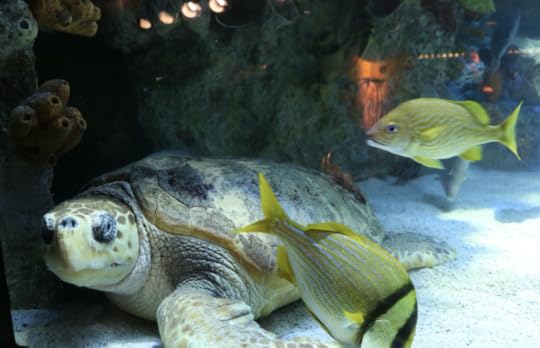
Retread (timeline photo from the New England Aquarium)
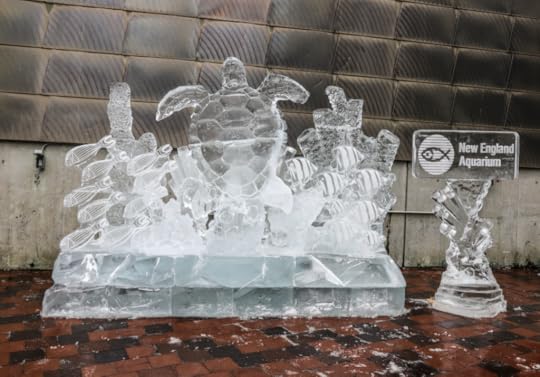
December 30, 2019
Preserving Artifacts from the Whydah Pirate Shipwreck, Cape Cod
If you ever have the opportunity to visit the Whydah Museum in West Yarmouth, MA, I strongly recommend that you take a look. I was there last week, and although the history of the Whydah ship, a slave ship captured and turned into a pirate ship, was interesting, what I found truly fascinating was the way that the Whydah’s artifacts were found and revealed.
The Whydah met its untimely demise when a storm blew up in a bad nor’easter in April of 1717. After a struggle to keep her afloat, the Whydah hit a sandbar off the coast of Wellfleet, Cape Cod and sank. Although many knew of the Whydah‘s sinking, it wasn’t until 1985 that the ship’s bell was discovered by Barry Clifford. Artifacts of the Whydah have been slowly being brought to light ever since.
When metals are left for some time underwater, as would have happened in a shipwreck like the Whydah, they begin to disintegrate and combine with the ocean water’s salt. In time, rock, clay, sand, as well as other artifacts combine to create a concrete-like formation called a concretion. As long as the concretion remains moist, the artifacts hidden inside remain stable. But if the concretion is allowed to dry out, any artifacts inside begin to rapidly disintegrate.
First, a diver needs to recognize a concretion when he or she sees one, and after it’s placed where it can be constantly kept wet, the process begins of discovering what artifacts might be caught inside. Two methods are used: either a concretion is x-rayed by a portable x-ray machine, which is often available on the boat as the concretion emerges from the sea, and/or a CT-scan image is taken of the concretion, which reveals a more detailed, yet more costly, view of what’s trapped inside. At the Whydah Museum, there were examples of concretions still intact, being bathed by water sprays, with the x-rays taken of artifacts hidden inside, beside the concretion.
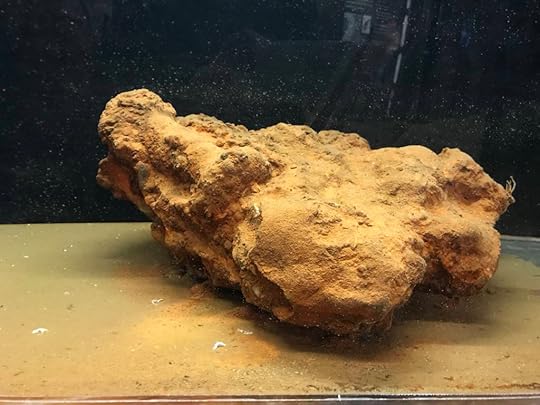
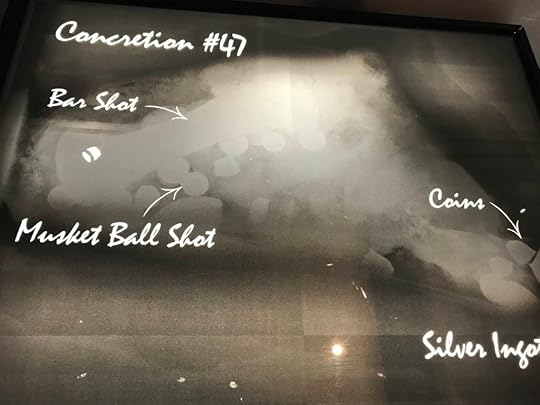
How the artifacts become separated from the concretion is a process. After being submerged in freshwater for two to four weeks, the concretion is placed in a chemical solution and low voltage electricity is applied. This process is called electrolytic reduction, and helps the salts to fall away from the artifacts, as well as any stone, iron oxide and debris that was attached. Picks, brushes and air scribes remove the remaining concretion, and the artifact is washed and coated with a sealant to protect the artifact from decay.
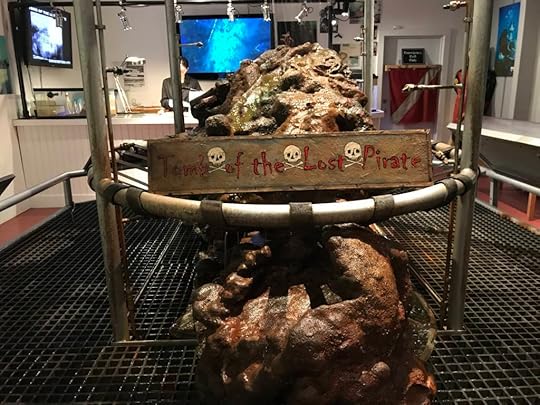 This is a large concretion that contains the bony remains of a pirate from the Whydah. Only two pirates survived the wreck of the Whydah.
This is a large concretion that contains the bony remains of a pirate from the Whydah. Only two pirates survived the wreck of the Whydah.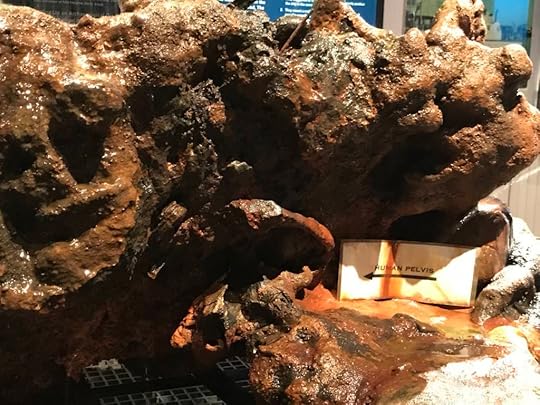 In the photo above, you can actually see the pelvis bone of the pirate, still partially encased in the concretion.
In the photo above, you can actually see the pelvis bone of the pirate, still partially encased in the concretion. 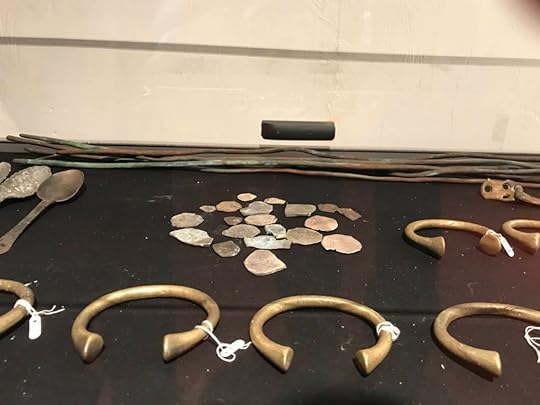 Coins, pewter spoons, and loops to support the sails collected from the Whydah wreckage.
Coins, pewter spoons, and loops to support the sails collected from the Whydah wreckage.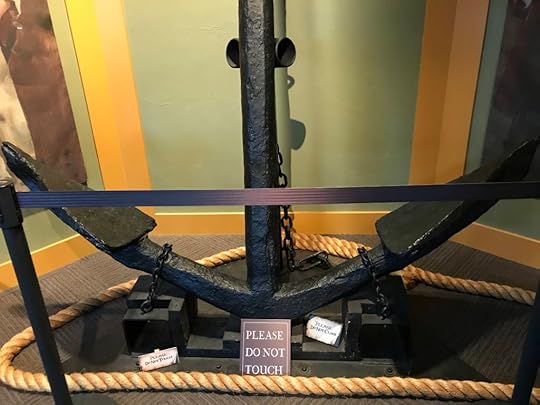
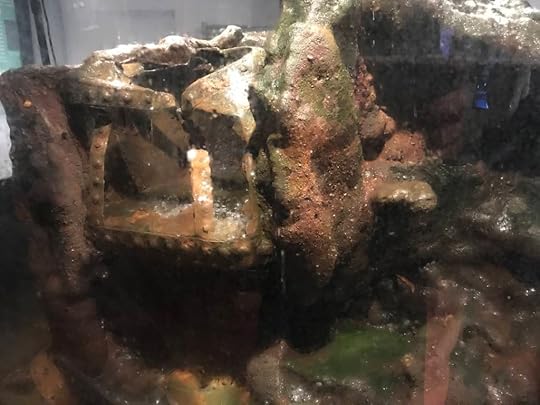 The Whydah anchor and the Whydah stove, partially exposed from a moist concretion.
The Whydah anchor and the Whydah stove, partially exposed from a moist concretion.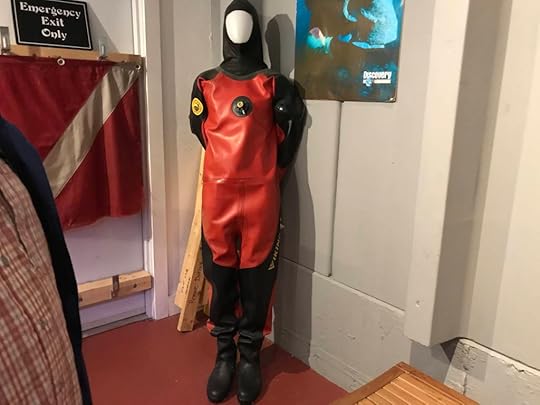
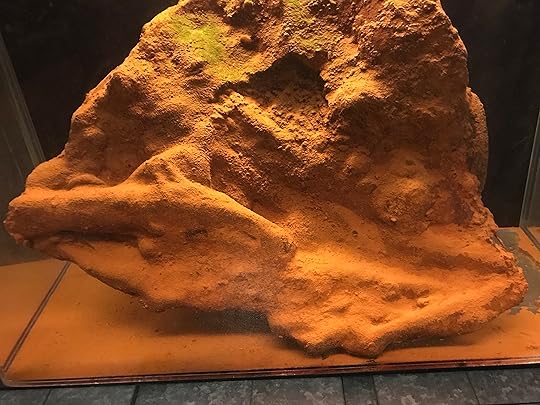 On the left: The very stylish outfit divers wore while collecting concretions from the Whydah. On the right: Can you spot the outline of a weapon in this concretion?
On the left: The very stylish outfit divers wore while collecting concretions from the Whydah. On the right: Can you spot the outline of a weapon in this concretion?
December 9, 2019
Fascinating Hammond Castle Book Signing
We learned so much about the fascinating Hammond Castle during our book signing on Saturday. Our table was nestled between a beautifully decorated Christmas tree, the skull of a Christopher Columbus crew mate, and a remote control weather controlled room, complete with lightning, containing an eight foot deep pool surrounded by a replica of a European marketplace. I’ve included some photos of this remarkable landmark, with each room decorated for the holidays. We were absolutely thrilled to have the opportunity to take part in these festivities!
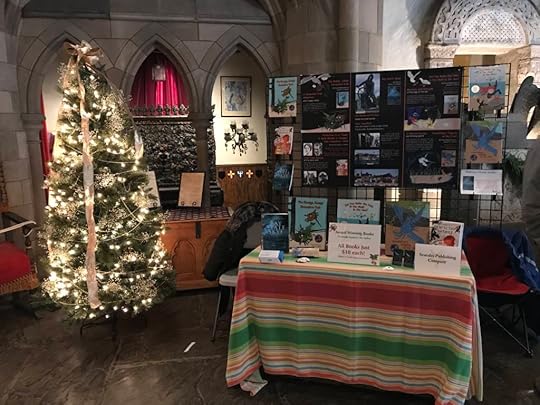
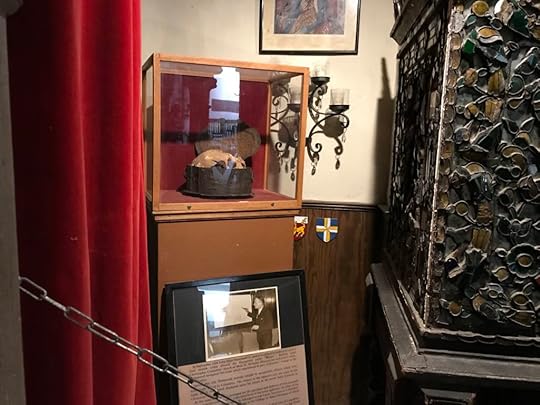
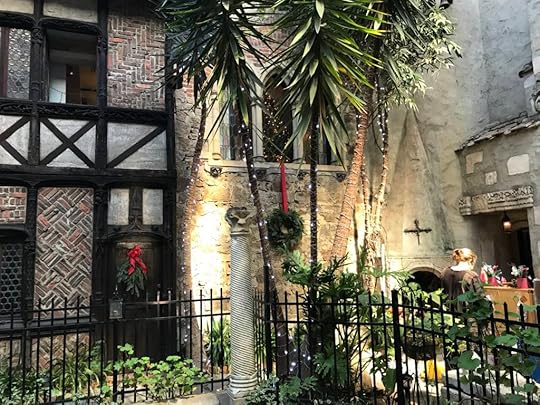
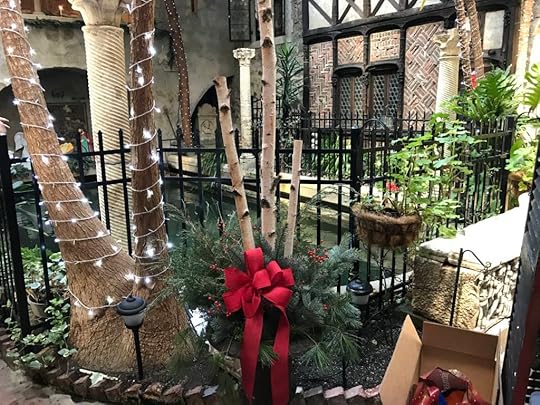
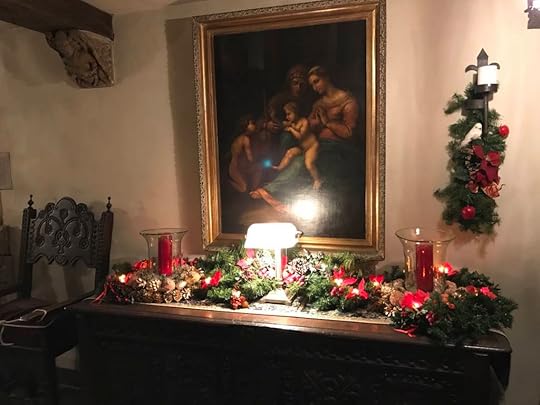
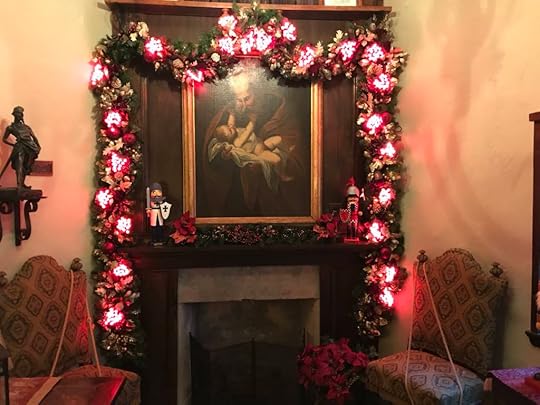
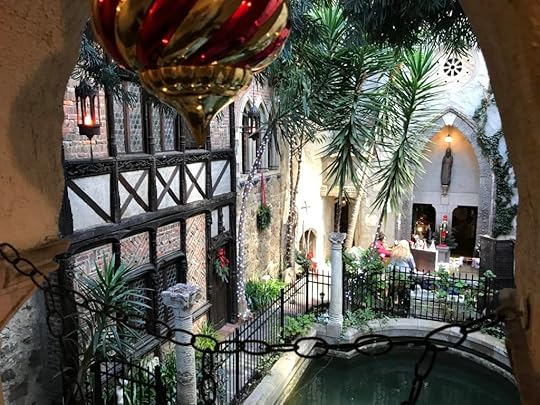
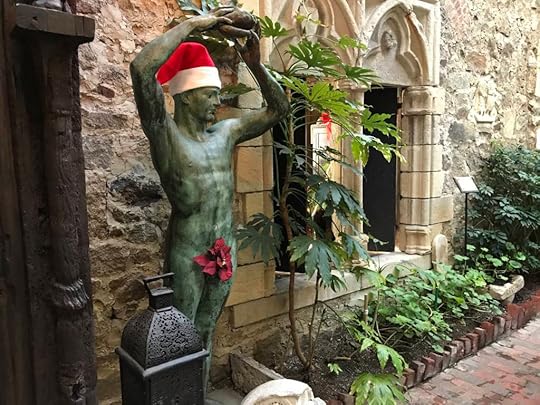
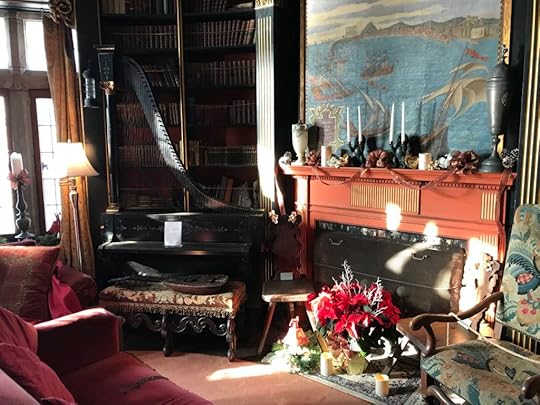
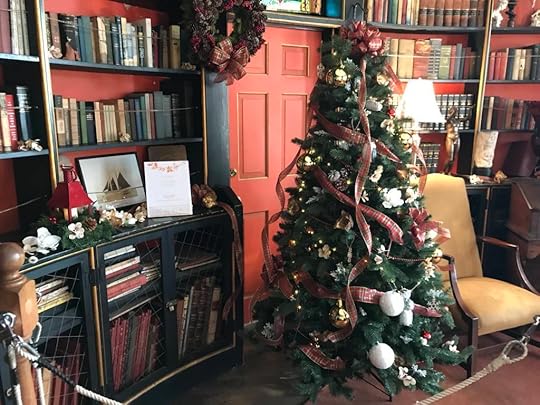
December 6, 2019
Incredible Look at Octopus Eggs
Octopus babies inside of their eggs.
Posted by Apolonis APHRODISIA on Thursday, December 5, 2019
These are octopus babies inside their eggs. According to the book, “Soul of an Octopus,” the female octopus lays her eggs towards the end of her life, and cares for them even at the expense of her own welfare. The octopus is a fascinating creature!



